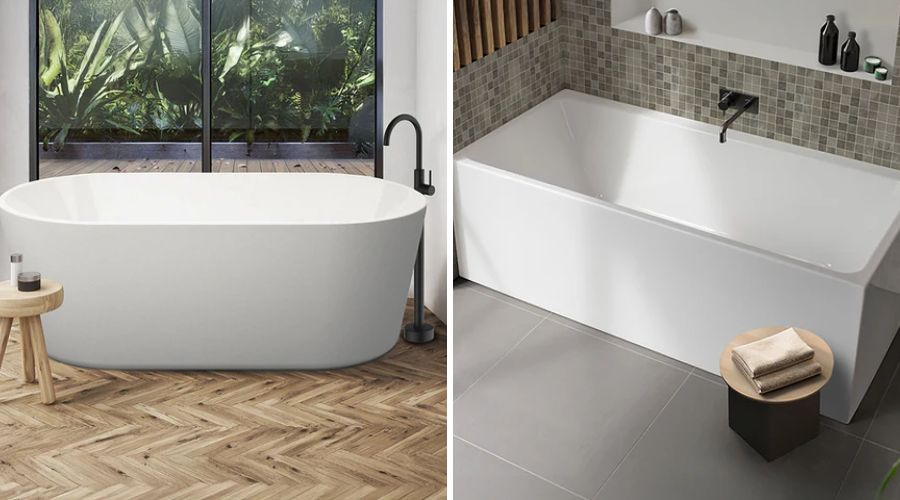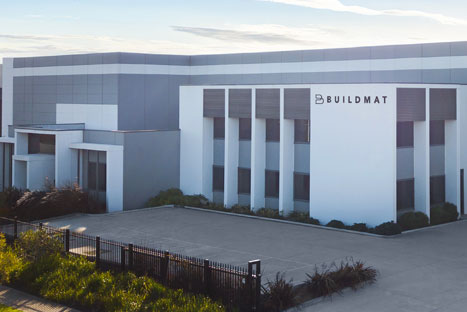Bathtubs Australia: What’s the Best Bathtub for Your Home?
Looking for the best bathtub for your home? This guide compares freestanding, built-in and corner tubs, outlines material pros and cons, and explains how to match your bath to your space, budget and lifestyle.

The best bathtub for your home depends on your bathroom size, layout, budget and how you like to bathe. Whether you’re soaking solo, managing bathtime for a toddler, or planning a full bathroom upgrade, this guide breaks down the main bathtub types, materials, trends and installation tips so you can choose the right fit with confidence.
This Fienza 1780mm solid surface bathtub is the epitome of luxury
Types of Bathtubs Available in Australia
From statement pieces to space-saving solutions, there’s a bath to suit every kind of Australian home. Here are the most common types you'll find.
- Freestanding bathtubs: Freestanding tubs are ideal for open layouts and larger bathrooms. They’re finished on all sides, which means they can sit in the middle of a room or near a feature wall. With sculptural shapes and solid surface finishes on offer, these are a go-to for modern bathroom design.
- Built-in or inset bathtubs: Built into a tiled surround or hob, these are the most traditional option and often the most space-efficient. They’re great for family homes and offer easy access for kids, cleaning and dual use as a shower base.
- Corner bathtubs: Corner designs make the most of unused space in square or awkward rooms. They’re available in left or right-hand setups and often feature generous soaking depth without a long footprint.
- Back-to-wall bathtubs: With the clean look of a freestanding tub but the space-saving practicality of a built-in, these are a smart choice for compact bathrooms. They sit flush against the wall for a seamless finish.
- Small bathtubs: Shorter in length but often deeper in design, compact tubs are perfect for en-suites, renovations or anywhere you’re working with limited space. You still get the relaxing soak without crowding the room.
- Spa bathtubs: Popular in Australian luxury bathrooms. Look for ergonomic shapes, hydrotherapy features or deep-sided styles designed for full immersion.
Decina’s back to wall corner bath is a popular option in Australian homes
How to Choose the Right Bathtub for Your Space
Before you fall in love with a bath design, make sure it actually works for your space and daily needs. Here’s what to consider.
Measure your available space
Start with the wall where your bath will sit. Note the length and depth you have to work with, and factor in clearance for doors, windows and other fittings. Small bathtubs can work in surprisingly small bathrooms if chosen well.
Think about your layout
Does your bathroom suit a freestanding bath, or would a back to wall or inset bath be more practical? Corner layouts might be better served by a corner bathtub, especially if you’re working with a square footprint.
Match the bath to how you use the space
If it’s your main bathroom, go for comfort and durability. If it’s an ensuite or guest bath, you might prioritise size and styling instead. Family bathrooms often benefit from built-in baths that double as a shower.
Work within your budget
Acrylic bathtubs are the most budget-friendly. Solid surface styles or designer shapes tend to cost more but offer a luxury finish and longer lifespan. Remember to factor in installation costs too, freestanding baths are easier to place but may need extra floor support.
|
Bath Type |
Best For |
Price Range |
Recommended Bathtub |
|
Larger bathrooms, open layouts, designer finishes |
$$$ – Premium |
||
|
Medium bathrooms, clean lines, easy maintenance |
$$ – Mid-range |
||
|
Compact family bathrooms, shower-bath combos |
$ – Affordable |
||
|
Small or square layouts, tricky reno spaces |
$$ – Mid-range |
||
|
Luxury bathrooms, spa-style soaking, bold finishes |
$$$$ – High-end |

This acrylic bathtub from Decina is budget friendly and built to last
Popular Bathtub Materials and Their Pros and Cons
Different materials affect the look, weight, durability and feel of your bath. Here’s a breakdown of what’s most common in Australian bathrooms.
Acrylic: Acrylic bathtubs are lightweight, affordable and available in a wide range of shapes and sizes. They’re warm to the touch, easy to install, and a great all-rounder for family homes or budget-conscious renovations. The finish can scratch over time, but most surface marks are easy to polish out.
Solid surface: Solid surface baths like stone composite and resin feel luxe and retain heat well. They’re matte in finish, naturally durable and visually seamless. They do weigh more than acrylic, so floor strength and professional installation are important to consider.
Cast iron or steel: Less common in new builds but still found in older homes, cast iron and steel baths are enamel-coated and incredibly durable. They’re heavy, cold to the touch at first, and usually more limited in shape. They suit traditional or heritage-style bathrooms.
Special finishes: Matte white remains popular for a modern, calming look. Gloss white feels bright and clean, while matte black makes a bold, architectural statement and resists fingerprints. Some ranges also feature soft earth tones like clay or sage to warm up minimalist bathrooms.
Recommended Bathtub Brands at Buildmat
|
Brand |
Best For |
Known For |
Popular Bathtub |
|
Family bathrooms, reliable everyday use |
Longstanding Aussie brand with practical features |
||
|
Home spa lovers, customers seeking Aussie-made luxury |
Spa and inset bath options |
||
|
Design-led bathrooms, soft feature finishes |
Fluted panels, matte textures, compact formats |
||
|
Practical layouts, small spaces, apartments |
Easy-clean shapes, space-conscious sizing |
How Do You Install a Bathtub?
Installing a bath isn’t just about putting it in place. Get it wrong, and you could face leaks, cracked tiles or costly rework. Here’s what to know before you start.
DIY vs professional installation
Acrylic or inset baths may seem easy enough to DIY, but proper waterproofing and drainage are key. Freestanding baths are generally simpler to position, but may still require a plumber to connect floor outlets and ensure falls are correct.
Know your clearances
Freestanding baths need around 50mm to 100mm of clearance around the base to allow for cleaning and comfortable access. Back to wall baths can sit flush, making them easier to clean in smaller rooms.
Check your floor strength
If you’re installing a solid surface bath, check whether your floor can handle the weight, especially if you’re on a second storey. You might need reinforcing before install.
Plan plumbing access
Make sure you leave room to reach the waste and trap for maintenance. This is especially important for freestanding or corner layouts where the plumbing might otherwise be concealed behind or beneath the bath.
Ensure correct waterproofing
Inset and back-to-wall baths require tiling and sealing around the edges to prevent leaks. Always check local waterproofing standards before you start.
Shop Buildmat’s Bathtub Range Online
Whether you're after a sculptural freestanding feature, a space-saving back to wall design or a family-friendly inset bath, Buildmat has a full range of bathtubs to suit every space, budget and style.
- Explore all Buildmat bathtubs
- Shop freestanding baths
- Browse back to wall baths
- See corner bathtubs
- View solid surface baths
- Discover small bath options
Looking for a specific look or brand? Explore bathware from trusted names like:
Looking for more? Check out our related bathtub articles:
- Matching Your Bathtub with Tapware: The Ultimate Style Guide
-
Freestanding Bathtubs vs Drop-In Bathtubs
Bathtubs Australia FAQs
Do I need to reinforce my floor for a solid surface bath?
Possibly. Solid surface baths are heavier than acrylic and may require additional floor support, especially on second-storey or suspended floors. Check the product weight and consult your installer.
How long does bath installation usually take?
For a simple acrylic drop-in or back to wall bath, installation can take a few hours. Freestanding baths or those requiring floor waste changes, waterproofing or tiling may take one to two days.
Can I install a bath without a hob or tiled surround?
Yes. Freestanding and back to wall bathtubs don’t require a hob. They can be installed directly onto a tiled floor, making them faster to install and easier to clean.
Which bath finish is easiest to maintain?
Gloss white is the most forgiving. It reflects light, hides water spots and is easy to clean. Matte white looks great but may need more gentle cleaning to avoid dulling over time. Black finishes can show soap marks but are a stylish choice in modern spaces.
What’s the difference between an overflow and no overflow bath?
An overflow is a built-in safety feature that prevents water from spilling over the edge. Some baths come with an integrated overflow, others don’t. Check the product spec or ask your plumber if you’re unsure which you need.





























































































































































































































